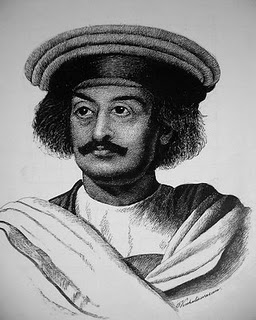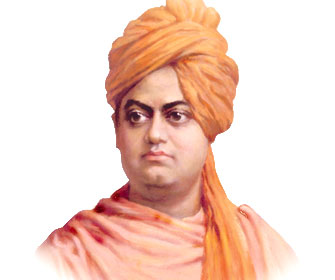Indian Freedom Struggle and Socio-cultural Reforms
Several incidences in Indian history can be seen where people rioted against the inhumanity caused by British government .The most important one was the revolt of 1857.
Revolt of 1857 -(The Indian Mutiny of 1857)
 |
| Mangal Pandey |
Causes of the revolt of 1857
There were many causes behind the revolt of 1857 .Through the Doctrine of Lapse many states were annexed to the British and titles and pensions of royals were suspended .Sepoys were mistreated and discriminated in terms of payment and promotions .
Levying of heavy taxes ,eviction and destruction of handicrafts industry due to one way free trade policy of the British caused dissatisfction among the Indians .But the most immediate cause for the mutiny was the introduction of the new Enfield rifle with geased cartridges (supposedly having acoating made up of fat of cow and pigs .Mangal Pandey ,a resident of Ballia district in Uttar Pradesh, was a soldier in the British Indian Army .He refused to use the greaced cartridges and broke into open mutiny at Barrakpoer near Calcutta .He had planned to join his comrades during mutiny .
The leaders of the revolt -
The revolution in Delhi was led by the leadership of Bhadur Shah II and General Bakht Khan.It was Ruthelessly supressed by John Nicolson and Lt Hudson .In Kanpur the leader of the revolts were Nana Sahib,Rao Sahib and Tantia Tope .Here Campbell and Havelock supressed the Revolt .Begum of Awadh (Hazrat Mahal)and Ahmadullah led the revolt in Lucknow and were supressed by Campbell and Havelock .Rani Laxmibai of Jhansi was defeated by Hugh Rose .The revolt was completely supressed by the end of 1858.
Other National movements are -
Indigo Revolt of Bengal (1859-60)-
The peasants of Bengal were forced to grow Indigo plants by the Europeans .Bishnucharan Biswas and Digambar Biswas played prominent roles in the resistance against the planters .
Indian Natioanl Congress -
The Indian National Congress was Formed by A O Hume ,an English retired civil servant ,in 1855,witha purpose to provide "a safety valve"to the growing discontent of the educated Indians .The first session of the INC was held in Bombay under the presidentship of W C Banerjee .
Swadeshi Movement (1905) -
In the Benaras session of INC in 1905,which was chaired by the president G K Gokhale ,the first call for Swadeshi Movement was made .Lala Lajpat Rai ,Bal Gangadhar Tilak,Bipin Chandr Pal and Aurbindo Ghosh played an important role here .
Swaraj (1906) -The INC under Dada bhai Nairoji called for Swaraj (self govt)in December 1906 at Calcutta session .
Ghadar Party - Was formed by Lala Hardayaal ,Soha Sing Bhakkna and Tarakhnath Das .Its headquarter was in San Francisco .
Home Rule Movement -(1916) - This movement was started by B G Tilak and Annie Besant with the objective of self government for India in British Empire .During this movement Tilak gave the slogan 'Swaraj is my birth right and I shall have it '.
Lucknow Pact (1916)-This pact was signed by INC and ML (Muslim League) .Both demanded dominion status for India .
Jallianwala Bagh Massacre (1919) - On 13 the April 1919 ,General O'Dyer fired at the people who were assembled in the Jallianwala Bagh ,Amritsar over protest against the arrest of the local leaders .The hunter commission was appointed to inquire into it .Sardar Udham Singh killed O'Dyer on 13 March 1940 at London .
Khilafat Movement - (1920) Muhammed Ali and Saukat Ali started the movement in protest against the mistreatment of the British on Turkey .
Non-Cooperation Movement -(1921-1922) The INC ,in Calcutta session ,passed the resolution in September 1920 to start the non cooperation movemnet .The movement started in January 1921 .
Moplah Rebillion (1921)- The Muslim Moplah peasants of Malabar (Kerela) rebelled against the Hindu Zamindars and the British government .As many as 2337 rebels were killed and many were injured .
Chauri Chaura incidence (1922)-The congress decided to launch the civil disobedience movement at the Allahabad Session in December 1921 ,but a mob attacked the police and burnt 22 policemen at Chauri Chaura (near Gorakhpur ) on 5 February .Gandhi ji withdrew non -cooperation momvement on 12 feb 1922 after this incidence .
Swaraj Party-(1923)- Moti Lal Nehru,C R Das and N C Kelkar formed the Swaraj Party on 1 January 1923 .The Party dissolved in 1926 with the death of C R Das .
Simon Commission (1927) - The Indian leaders opposed the Simon Commission ,which came to India in order to introduce futher reforms and extensions of parliamentry democracy .While protesting against the commission ,Lala Lajpat Rai died in a Lathi Charge at Lahore .
Bardoli Movement(1928) - The Bardoli movement was a 'no revenue' campgain by the Bardoli (a district in Gujrat) peasants under the leadership of sardar Vallabh Bhai Patel.
Lahore Session (1929) - Under the Presidentship of J Nehru,Inc declared Purna Swaraj .The newly adapted tricolour flaf was unfurled on 31 December 1929 ,and 26 January 1930 was fixed as the first Independence day to be celebrated every year.
Dandi March (1930)-On 12 March 1930,Gandhi ji started his march fromSabarmati Ashram to Dandi to break the salt Law imposed bythe British .On 6 April 1930 ,he picked a handful of salt and started the civil disobedience movement .When he was arrested ,Sarojini Naidu led the movement .
First Round table conference (1930)-It was held on 12 November 1930 in London to disscuss the Simon commission report .
Gandhi Erwin Pact (1931) - A pact was signed between Gandhi ji and the Governor General lord Irwin in March 1931 .As a result the congress withdrew the civil disobedience movement and the government ,on its part ,released political prisoners and permitted the people to make salt for the persons residing within the certain distance of the sea coast .
Second Round Table conference (1931) -THe second round table conference was held on 12 november 1930 in London to discuss the Simon Commission Report .
Poona Pact (1932)-According to this pact ,the seats reserved for the depressed classes in the provincial legislatue was increased .The Third Round Table conference was held in 1932,which did not bring about any result .
Government of India Act 1935 -Thsi act was passed based on SimonCommission report.A federal type of government was introduced .
Quit India movement (1942)-On 8 August 1942 ,the resolution of quit India movement was passed in Bombay.Gandhiji asked the British to quit India and gave slogan 'Do or Die 'to his countrymen .
Indian National Army(INA) .In 1942 Subhash Chandra Bose formed Azad Hind Fauz in Singapoer and gave the call "Dilli chalo".INA had three fighting brigades named after Gandhi Ji ,Azad and Nehru and one women force named after Rani Jhansi .Its headquarters were at two places .Singapore and Rangoon.
Socio cultural Reforms -
Raja Ram Mohan Roy - founded the Brahmo Samaj in 1885.He opposed Sati Pratha,casteism and advocated widow remarriage .He is regarded as the Father of Indian Renaissance due to his efforts to protect Hinduism and Indian's rights by participating in English government .
Keshab Chandra -He started Sangat Sabha and Prarthana Samaj.
M G Ranade-He founded the Prarthana Sabha .
Swami Dayanand -He founded the Arya Samaj in 1875.
Swami Vivekanand (1863-1902)- He founded the Ramkrishna Mission in 1897.He attended the Parliament of Religion at Chicago in 1893 and gave an influential speech addressing the crowd "Sisters and Brothers of America ...".He introduced Hinduism there .He indroduced Indian Philosophies of Vedanta and Yoga to the Western World.
Raja Ram Mohan Roy
Henry Louis Vivian Derozio-The Young Bengal Movement was propagated by Henry Louis Vivian Derozio .He was a lecturer at the Hindu college of Calcutta.Though he was of Portugal origin but he had a great spirit of patriotism for his native land Bengal .In his poem native land he wrote
“My Country! In the days of Glory Past
A beauteous halo circled round thy brow
And worshiped as deity thou wast,
Where is that Glory, where is that reverence now?”
Jyotiba Phule - Satya Sodhak Samaj was founded Swami Vivekanand by Jyotiba Phule in 1873.
Madam H P Blavatsky- She began the movement of Theosophical Society in the United States in 1875.In India it was popularized by Annie Besant (who was also the president of this society in 1907 ),and she founded the Central Hindu College in 1898.
India After Independence -
Pt Nehru became the first prime minister of India .On 30 January 1984,Gandhi ji was assasinated by Nathuram Vinayak Godse .On 26 January 1950 ,India became a republic and Dr Rajendra Prasad became the first president and Dr S Radha Krishnan the first Vice President of India.









0 comments:
Post a Comment